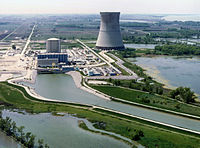
Photo from wikipedia
The Atomic Energy Act, as amended, authorizes the United States (U.S.) Department of Energy (DOE) and its predecessor agencies to distribute nuclear materials to public or private institutions for the… Click to show full abstract
The Atomic Energy Act, as amended, authorizes the United States (U.S.) Department of Energy (DOE) and its predecessor agencies to distribute nuclear materials to public or private institutions for the purposes of education as well as research and development. Significant transformations throughout the nuclear industry have led to changes in programmatic responsibility for loaned nuclear materials. DOE has established several programs to catalog, transfer ownership, retrieve, and/or dispose of these loaned nuclear materials. The variety of loaned nuclear material types as well as operational and regulatory variations between facility licensees have created unique challenges for the retrieval and dispositioning processes. These include packaging and transportation, confirmation of regulatory jurisdiction, property transfer, and disposal of sources with no remaining economic value. This paper explores the methods and actions taken by DOE to address these challenges. Lessons learned and the best practices identified from these programs are also presented.
Journal Title: Journal of Nuclear Engineering and Radiation Science
Year Published: 2020
Link to full text (if available)
Share on Social Media: Sign Up to like & get
recommendations!